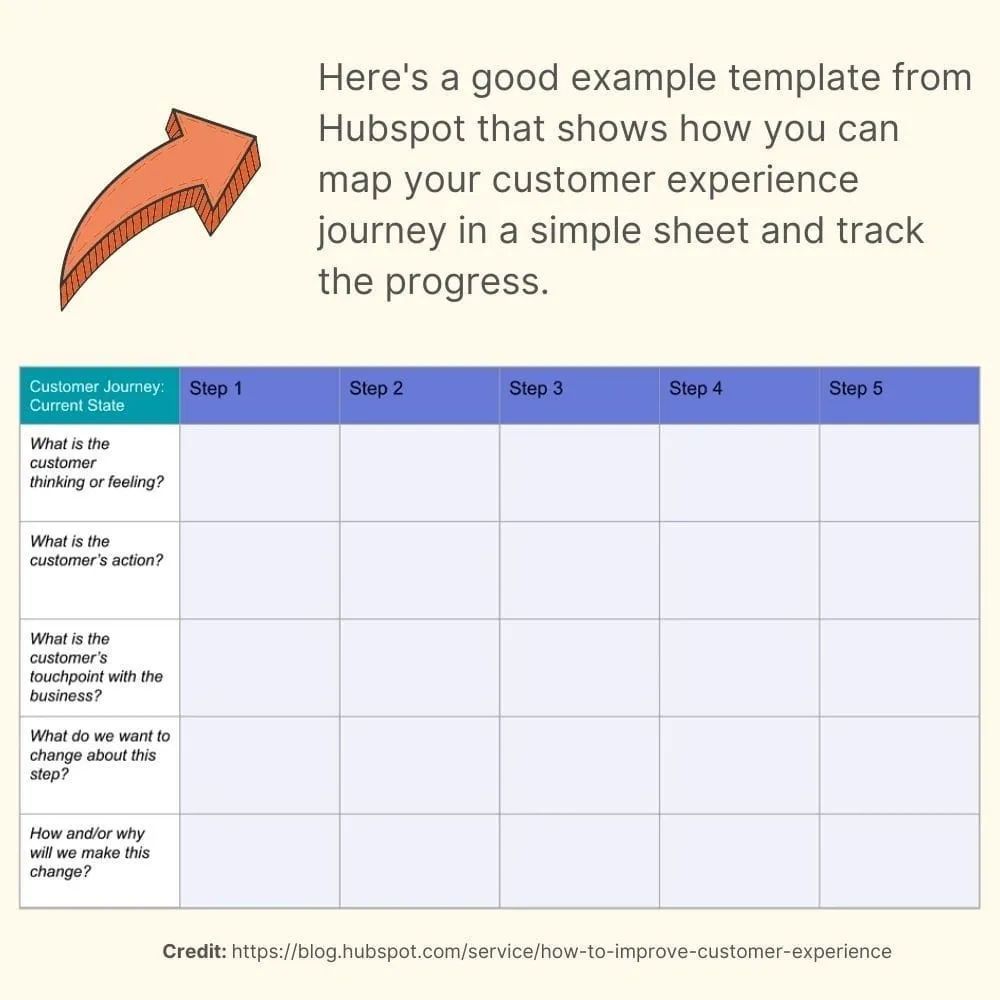Un guide complet de l'expérience client
Vous cherchez à améliorer l'expérience client sur tous les points de contact ? Découvrez comment créer une culture centrée sur le client grâce à la cartographie des parcours, à la personnalisation et aux récompenses numériques. Apprenez des stratégies concrètes qui favorisent la fidélité et la rétention à chaque étape.
Sur cette page
- Qu'est-ce que l'expérience client ?
- Pourquoi l'expérience client est-elle importante pour une entreprise ?
- Comment améliorer l'expérience client ?
- Comment mesurer l'expérience client de manière approfondie ?
- Comment les récompenses et les cadeaux peuvent améliorer l'expérience des clients
- Dernières réflexions
Ceux qui se promènent régulièrement les yeux grands ouverts dans le couloir du marketing ne seront pas surpris de voir l'évolution de l'expérience client. l'expérience client d'une entité post-vente à un nouveau terrain distinct, celui du marketing concurrentiel.
Elle perturbe fortement ceux qui croient que le duo éprouvé et fiable du produit et du prix suffira à les catapulter dans les hautes sphères du succès.
Bien que les experts aient déclaré que la prochaine décennie verrait l'expérience du client l'emporter sur le produit, la vitesse du changement l'a retardée, puisqu'elle est déjà arrivée.
Ce guide complet de l'expérience client explique la signification réelle de l'expérience client, pourquoi elle est inévitablement importante, et les méthodes actionnables que vous pouvez utiliser pour améliorer l'expérience client résultante de votre organisation.
80 % des clients déclarent que l'expérience offerte par une entreprise est aussi importante que ses produits et services.
49 % des clients déclarent avoir effectué des achats impulsifs après avoir vécu des expériences personnalisées.
Le rapport de Deloitte souligne que trois clients sur quatre sont plus fidèles aux magasins offrant une expérience client cohérente.
Un article de Forbes note qu'en 2024, 64 % des clients déclareront qu'indépendamment de l'appréciation du produit, un service client médiocre les incitera à chercher d'autres solutions.
Qu'est-ce que l'expérience client ?
Un programme d'expérience client est une stratégie structurée visant à améliorer chaque interaction de votre entreprise avec ses clients. Il est axé sur la collecte active de commentaires, la compréhension des perceptions des clients et l'utilisation de ces informations pour apporter des améliorations significatives.
L'expérience client est l'impression globale qu'un client a d'une marque dans tous les aspects du parcours de l'acheteur. Elle a un impact sur les résultats d'une marque, y compris sur son chiffre d'affaires.(Source : Hubspot)
Nombreux sont ceux qui confondent encore l'expérience client avec le simple service à la clientèle. Bien que le service soit un élément clé, l'expérience client est beaucoup plus large, car elle est façonnée par les parcours complexes et multicanaux des clients d'aujourd'hui. Elle englobe toutes les interactions entre un client et une marque, des points de contact aux environnements. En d'autres termes, l'expérience client est devenue un système dynamique à multiples facettes.
Pourquoi l'expérience client est-elle importante pour une entreprise ?
Une bonne expérience client encourage la fidélité et peut transformer les consommateurs en défenseurs de la marque. En revanche, les mauvaises expériences ont l'effet inverse, et c'est la raison pour laquelle l'expérience client est la plus importante. Comprenons également quelques autres raisons vitales de son importance.
1. La satisfaction du client n'a jamais été aussi importante qu'aujourd'hui
La voie vers la satisfaction du client passe par la satisfaction des attentes des clients, qui se sont rapidement métastasées.
Une bonne expérience client, avec des informations détaillées avant la vente et des interactions humaines après la vente, peut facilement produire des clients plus satisfaits en ne se contentant pas de répondre à leurs attentes, mais en les dépassant.
Il est important de souligner que les entreprises du monde entier ont un taux de satisfaction de la clientèle detaux moyen de satisfaction de la clientèlede 86 %, ce qui laisse une grande marge de progression.
2. L'expérience client stimule les résultats - directement et indirectement
La valeur économique se situe à l'intersection des attentes des clients et de l'expérience vécue par ces derniers. Lorsque les clients interagissent avec votre organisation, ils veulent extraire un maximum de valeur avec un minimum de moyens.
C'est l'idée qu'ils se font de la satisfaction. Une bonne expérience client peut donc avoir un impact positif sur leur comportement d'achat et se traduire par une augmentation du chiffre d'affaires, une réduction du coût des services et une amélioration du retour sur investissement.
3. L'expérience client garantit la résilience de l'entreprise
Les organisations centrées sur le client sont souvent récompensées par le marché et les clients. Une bonne expérience client signifie implicitement que vous vous êtes bien adapté aux besoins des clients en concevant des parcours client de bout en bout qui mettent l'accent sur la gestion de la relation client.
Elle confère à votre entreprise une plus grande résilience, vous protégeant de la colère des clients et de la sensibilité aux prix.
4. L'expérience client garantit un avantage concurrentiel
A étude réalisée en 2024 par Forrester a révélé que les entreprises offrant une expérience client (CX) de qualité supérieure enregistrent une croissance de leur chiffre d'affaires jusqu'à 3,5 fois supérieure à celle de leurs concurrents, ce qui souligne le rôle essentiel de la CX dans la réussite de l'entreprise.
Il semble donc parfaitement logique queTony Alessandra,président de l'Assessment Business Center, déclare : "Être à égalité en termes de prix et de qualité ne vous permet que d'entrer dans le jeu. C'est le service qui l'emporte".
Il est toujours possible que les concurrents reproduisent la dynamique de qualité, de produit et de prix qui est la vôtre, mais la touche d'individualisation et de personnalisation qu'apporte l'expérience du client peut vous être propre. Elle peut devenir votre produit lui-même, ce qui est très difficile à reproduire, voire impossible.
Comment améliorer l'expérience client ?
Les avantages qu'une expérience client hors du commun lègue aux entreprises sont en effet tentants, ce qui pousse n'importe qui à mettre le pied sur la pédale de l'expérience de manière impulsive.
Cependant, la réalité est qu'à l'exception des entreprises les plus performantes, très peu d'entre elles l'ont appréhendé de manière exhaustive et en ont fait leur propre expert exclusif.
Une série d'obstacles - ne pas savoir ce que veulent exactement les clients, où ils se trouvent, comment être là pour eux quand ils ont besoin de vous, ne pas savoir comment ajouter de la valeur grâce à l'expérience client - ont entravé leurs efforts en matière d'expérience client.
La seule façon de s'en sortir est de décider d'actions clés fondamentales impliquant une compréhension plus approfondie des clients et de leur environnement et de concevoir d'autres actions subsidiaires qui tournent autour d'elles.

Voici dix moyens efficaces d'améliorer l'expérience client :
1. Cartographier judicieusement le parcours du client
Comprenez votre client aussi clairement que vous comprenez vos propres besoins. Savoir directement d'où viennent les clients, comment ils arrivent sur vos différents points de contact, ce qu'ils vivent en traversant ces points de contact et ce qu'ils attendent est la seule base fiable sur laquelle l'édifice d'une expérience client exceptionnelle peut être construit.
L'énonciation d'une carte claire du parcours du client est donc le premier moteur de l'expérience client.

Une carte du parcours client est une esquisse détaillée de chaque étape franchie par vos clients lorsqu'ils interagissent avec votre organisation. C'est pourquoi elle inclut des engagements allant au-delà de l'achat du produit, comme les médias sociaux, les publicités et les études de cas sur votre site web.
L'expérience client étant par nature holistique, il est essentiel d'inclure les activités d'avant-vente et d'après-vente dans votre cartographie.
Bien que les entreprises se concentrent souvent sur les activités de vente, il est essentiel de prêter attention aux interactions après-vente, non seulement pour offrir une expérience client complète, mais aussi pour favoriser la fidélisation de la clientèle.
Pourquoi est-il important de cartographier votre parcours client ?
Un parcours client bien cartographié donne à vos employés une vue d'ensemble de l'expérience client, du début à la fin, et les aide à visualiser les points problématiques et leurs solutions.
Une fois que les employés reconnaissent leur contribution individuelle, l'expérience client supérieure devient naturellement une pierre de touche culturelle dans l'ensemble de l'organisation.
2. Affiner la stratégie omnicanale
Une fois que vous avez dressé la liste des différents modes par lesquels les clients peuvent vous découvrir et interagir avec vous, l'étape suivante consiste à comprendre le comportement des clients sur ces canaux et à l'intégrer de manière transparente dans votre cadre de vente et de marketing.
Notez que cela n'améliore pas seulement vos possibilités d'entrer en contact avec vos clients. C'est ce que les clients souhaitent ouvertement et secrètement.
SelonCX Today9 clients sur 10 attendent une expérience omnicanale comme méthode de communication privilégiée.
Cette attente d'une expérience omnicanale s'explique par deux raisons :
- Raison n° 1 :les clients veulent une expérience homogène, cohérente et familière sur tous les canaux, ce qui fait que toute forme de cloisonnement est un péché.
- Raison n° 2 :Dans une pléthore de gadgets qui frise l'avalanche, les clients s'attendent à la joie et à la liberté d'interagir par le biais du mode qu'ils préfèrent. S'attendre à ce que les clients ne préfèrent qu'un seul mode de communication est donc un moyen sûr de vous planter dans le pot de l'insignifiance.
Pourquoi est-il important d'adopter une approche omnicanale ?
Une commodité renforcée : La liberté d'interaction à tout moment et en tout lieu par le biais des modes préférés se traduit par la commodité, qui est au cœur d'une expérience client exceptionnelle. Elle permet d'identifier les moments où les clients sont prêts à agir. Google appelle cela des "micro-moments" - des décisions et des préférences basées sur l'intention qui façonnent le parcours du consommateur. Sans une communication ouverte et intégrée, tirer parti de ces moments revient à tracer des lignes sur l'eau.
Exploiter la puissance des données : Les stratégies omnicanales génèrent des données récurrentes et exploitables, qui constituent une riche base d'informations sur les consommateurs. L'utilisation scientifique de ces données vous aide à répondre aux besoins et aux tendances de manière proactive. Elle met également en évidence les points de friction dans le parcours du client qui peuvent être résolus grâce à cette nouvelle clarté.
Points de friction communs :
- Les formulaires de plainte sont trop longs
- L'appel à l'action est noyé dans une navigation complexe
- Le bon contenu est difficile à trouver
- Les pop-ups croisent les actes clés
- Saisir à nouveau les mêmes informations sur plusieurs pages
- Difficultés liées à l'utilisation de différents appareils
- Pas de FAQ
3. L'intelligence artificielle (IA)
La douleur des clients n'a pas d'heure fixe. Parfois, il est humainement impossible d'être présent à tout moment pour vos clients. L'IA, avec les chatbots, peut combler efficacement ce vide flagrant.
Dotés d'un apprentissage profond et d'algorithmes avancés, ils accélèrent le temps de réponse et répondent à 80 % des questions fréquemment posées. Par conséquent, les chatbots permettent d'économiser jusqu'à30 % sur les coûts de support client.
Pourquoi est-il important d'avoir des chatbots ?
- Les chatbots répondent aux questions des clients 24 heures sur 24 et 7 jours sur 7, même lorsque votre équipe d'assistance n'est pas disponible. Garantir des réponses rapides permet aux clients de se sentir valorisés, ce qui est la clé de voûte d'une bonne expérience client.
- La mise en place de bots en tant que premier contact avec le client permet de collecter des informations de base sur le client, ce qui permet d'approfondir l'analyse.
- Contrairement aux humains, les robots peuvent être facilement dimensionnés pendant les heures de pointe pour fournir une assistance de qualité sans manquer un seul iota de conversation.
Il n'est donc pas surprenant que 30 % des consommateurs américains considèrent les interactions avec les chatbots comme "très efficaces" pour résoudre les problèmes liés au service client. Pourquoi pensez-vous que cela est possible ?Les fonctions d'activationpermettent d'automatiser les conversations - un exploit impressionnant, en effet !
4. Intégrer des options de libre-service
Quelle que soit la qualité de la formation de votre équipe d'assistance à la clientèle, il s'agit toujours d'une solution réactive à des problèmes mineurs récurrents, ce qui entraîne des retards et des coûts supplémentaires. Une stratégie plus intelligente consiste à laisser les clients résoudre eux-mêmes les petits problèmes non critiques.
Votre équipe d'assistance peut ainsi se concentrer sur les problèmes urgents qui comptent vraiment, ce qui permet souvent de sauver des clients qui risquent de se désabonner. Même les utilisateurs préfèrent résoudre les problèmes de base de manière autonome.
Pourquoi est-il important d'intégrer des options de libre-service ?
Le libre-service offre ce que l'assistance traditionnelle ne peut souvent pas offrir : des expériences rapides, intuitives et satisfaisantes. Il responsabilise les clients en
- La navigation intelligente permet d'obtenir instantanément les informations nécessaires.
- Fournir des outils pour résoudre les petits problèmes de manière autonome.
- Renforcer votre marque en permettant des interactions sans friction.
5. Fournir un service à la clientèle emblématique
Il existe de nombreux cas de figure où clients se sont débarrassés alors qu'ils étaient satisfaits du produit. Le plus souvent, le suspect habituel est un mauvais service à la clientèle.
Et avec78%des clients renoncent à un achat en raison d'un mauvais service à la clientèle, il n'est pas nécessaire de se munir de jumelles pour voir l'impact négatif que cela peut avoir sur la santé financière d'une entreprise.
En général, un bon service à la clientèle signifie un service qui est.. :
- Rapide ("en temps réel")
- Personnalisé
- Expérientiel
- Proactive, elle propose une résolution avant qu'une perturbation ne se produise.
6. Écouter les clients - toujours
La perception de vos clients est la réalité de votre marque. Il est donc essentiel de comprendre parfaitement ce qu'ils attendent, ce qu'ils pensent de leur collaboration avec vous, quels sont les points à améliorer et s'ils sont prêts à recommander votre marque à d'autres.
La meilleure façon de procéder est d'entrer en contact avec vos clients par le biais de tous les canaux possibles et de leur demander régulièrement un retour d'information.
55 % des consommateurs ont souligné l'importance d'employés compétents dans leur expérience du service à la clientèle.
Une fois condensées dans le tube d'analyse, les entreprises peuvent utiliser ces pépites d'information pour améliorer leur service à la clientèle.
Pourquoi est-il important de toujours écouter les clients ?
- Une mise en œuvre attentive du retour d'information garantit que le produit final et le service à la clientèle répondront aux attentes des clients et les rendront ainsi satisfaits.
- Le simple fait de travailler dur pour recueillir des informations montre que vous accordez de l'importance à l'opinion de vos clients, ce qui leur permet de se sentir étroitement liés à votre entreprise.
- Un retour d'information honnête, régulier et détaillé permet de quantifier le quotient de satisfaction du client et d'ouvrir de nouvelles possibilités de vente incitative et de vente croisée.
7. Tirer des enseignements de l'attrition de la clientèle
Bain & Companysuggère qu'une augmentation de 5 % de la fidélisation de la clientèle peut accroître les bénéfices de votre entreprise de 25 % à 95 %. Il s'agit d'abord d'analyser les domaines de l'expérience client où l'engagement est faible.
Même si vous ne parvenez pas à empêcher les départs, essayez de savoir pourquoi ils sont partis. Demandez-leur de laisser un commentaire et réfléchissez-y sérieusement. Déterminez les cas où votre entreprise n'a pas été à la hauteur et transmettez-les aux personnes concernées pour qu'elles y remédient à l'avenir.
En facilitant la résiliation pour leclient de résilier son compte et en le laissant partir gracieusement, laissez-lui une bonne dernière impression.et en le laissant partir gracieusement, vous laissez une bonne dernière impression. Ainsi, lorsqu'il décidera de s'inscrire pour le même produit, vous serez la première personne qui lui viendra à l'esprit.
Pourquoi est-il important de prévenir le désabonnement ?
- Étant donné qu'un faible engagement est le précurseur du désengagement final, voire inévitable, l'analyse de l'engagement vous permet d'identifier les clients qui présentent le risque le plus élevé de désengagement.
- Vous pouvez également évaluer le pourcentage d'engagement qui entraînera un désabonnement et alerter votre service desuccès clientà ce sujet. Vous avez ainsi la possibilité d'établir un contact proactif avec les clients avant qu'il ne soit trop tard.
8. S'engager auprès de ses clients tout au long de leur cycle de vie
Avec d'innombrables points de contact et de nouveaux gadgets, le parcours du client moderne est loin d'être linéaire - il est plein de rebondissements.
Pour éviter les abandons, guidez soigneusement les clients à travers chaque étape.
Depuis 80% des consommateurs changent d'entreprise après plusieurs mauvaises expériences, une expérience client solide est essentielle pour les faire avancer dans l'entonnoir.
Smart Insights a révélé que 50 % des entreprises considèrent le CX basé sur le parcours comme "extrêmement important", et 30 % comme "très important".
Pour exceller, observez attentivement le parcours et éliminez les points de friction, comme un site Web lent à l'étape de la sensibilisation ou de longs formulaires de démonstration à l'étape de la prise de décision.
En éliminant ces obstacles grâce à un excellent CX, vous vous assurez de rencontrer les clients à la ligne d'arrivée.
Pourquoi impliquer les clients tout au long de leur parcours ?
- Il augmente la valeur de la durée de vie et le retour sur investissement.
- Une CX forte réduit les dépenses de marketing à long terme.
- Les clients satisfaits deviennent des ambassadeurs, ce qui rend les publicités moins nécessaires.
9. Construire une culture centrée sur le client
Une entreprise ne peut réussir sans des clients heureux et satisfaits. L'orientation client est une stratégie et une culture qui se concentrent sur la fourniture d'expériences exceptionnelles afin de fidéliser les clients. Il s'agit de placer le client au cœur de toutes les activités, sans pour autant grever votre budget. Même de petits gestes peuvent faire beaucoup pour que les clients se sentent valorisés.
- Faites plaisir à vos clients en leur offrant des cadeaux :Puisque le monde n'a pas encore vu une façon plus joyeuse de faire plaisir à une personne que de lui offrir un souvenir de son choix. de faire plaisir à quelqu'un que de lui offrir un souvenir de son choixL'offre stratégique de cadeaux à l'occasion de moments clés de la vie personnelle ou professionnelle de vos clients peut vous assurer une place permanente dans leur carnet d'adresses.
- Donnez-leur un accès anticipé :Unmoyen simple de faire en sorte que vos clients se sentent spéciaux est de leur donner un accès anticipé aux produits ou services nouvellement lancés.
- Offrez des remises aux clients qui dépensent beaucoup :Augmentez lavaleur de vos commandes et le taux de renouvellement de vos achats en offrant des remises mesurées à vos acheteurs réguliers.
Pourquoi est-il important d'instaurer une culture centrée sur le client ?
Une approche axée sur le client permet aux gens de se sentir appréciés et de se sentir au cœur de votre entreprise. Ce lien émotionnel permet de garder votre marque en tête, d'augmenter leur tolérance aux petits écarts et de diminuer la sensibilité au prix, ce qui contribue à réduire le taux d'attrition.
Elle est reprise sans équivoque dans l'étude menée parDeloitte et Touche: Les entreprises centrées sur le client sont 60 % plus rentables que les entreprises non centrées sur le client.
10. Transmettre les données relatives à l'expérience client à toutes les équipes
L'expérience client est une bataille épuisante et sans fin qui doit être menée par l'ensemble de l'organisation - et votre équipe CX n'en gère qu'une partie.
C'est pourquoi il est impératif que tous les membres de votre organisation aient facilement accès à vos résultats en matière d'expérience client.
Cette confrontation constante et directe avec la réalité les aidera à analyser leur travail, ce qui permettra d'optimiser les processus quotidiens, pourtant essentiels, tels que l'acheminement des clients, l'automatisation du flux de travail et le marquage des clients.
Pourquoi est-il crucial de transmettre à vos équipes les données relatives à l'expérience client ?
- Un recours plus rapide pour les clients :Metasaasindique que 31 % des licences SaaS restent inutilisées, ce qui souligne la nécessité d'éliminer les obstacles le plus rapidement possible. Le fait de disposer de données complètes et en temps réel sur les obstacles auxquels vos clients sont susceptibles de se heurter permet à votre équipe de prévoir la frustration des utilisateurs et d'opter pour des mesures proactives afin de faciliter le parcours du client.
- Amélioration des possibilités de vente incitative :Grâce à uneconnaissance approfondie du moment opportun pour contacter les clients, de leurs canaux de communication préférés et de leurs besoins urgents, votre équipe de vente sera en mesure d'identifier les nouvelles opportunités de vente incitative aussi clairement qu'en plein jour.
Comment mesurer l'expérience client de manière approfondie ?
Il existe deux méthodes principales pour évaluer l'expérience client :
- Enquêtes auprès des clients: Interrogez directement les clients sur leurs expériences en envoyant des enquêtes après une interaction.
- Analyse des données d'assistance: Suivez les mesures du support client de première partie pour comprendre la qualité, la rapidité et l'efficacité du service fourni par votre équipe.
L'approche la plus efficace combine les deux méthodes. Les indicateurs clés de performance du service à la clientèle fixent des critères de performance, tandis que les enquêtes offrent un retour d'information direct de la part des clients et révèlent dans quelle mesure vous répondez réellement à leurs attentes.
Il existe des centaines d'indicateurs CX que vous pouvez suivre, mais certains sont universellement importants dans tous les secteurs. Nous allons nous pencher sur les plus importants d'entre eux :
1. Net Promoter Score (NPS)
Le Net Promoter Score mesure la fidélité des clients en posant une question simple :
"Quelle est la probabilité que vous nous recommandiez à un ami ou à un collègue ?"
Les réponses sont évaluées sur une échelle de 0 à 10 :
- 0-6: Détracteurs (clients mécontents)
- 7-8: Passives (satisfaites mais pas enthousiastes)
- 9-10: Promoteurs (enthousiastes fidèles)
Pour calculer votre NPS, soustrayez le pourcentage de détracteurs du pourcentage de promoteurs. Un NPS élevé indique que les clients aiment votre marque et sont prêts à la défendre.
2. Satisfaction du client (CSAT)
Le CSAT est un autre indicateur largement utilisé, recueilli par le biais d'enquêtes simples à une seule question, telles que : "Quel est votre degré de satisfaction à l'égard de votre expérience ?
"Dans quelle mesure avez-vous été satisfait de votre expérience ?"
Les réponses offrent généralement des options telles que "Satisfait" ou "Insatisfait", souvent accompagnées d'une boîte de commentaires facultative.
Les entreprises peuvent envoyer des enquêtes CSAT après des interactions d'assistance, ou à différents points de contact avec le client, par exemple après la livraison d'un produit ou un achat en ligne. Le suivi du CSAT à différents stades vous permet de déterminer avec précision les points à améliorer.
3. Score d'effort du client (CES)
Le Customer Effort Score mesure la facilité avec laquelle un client effectue une action, comme résoudre un problème ou effectuer un retour.
Les clients sont interrogés :
"Dans quelle mesure votre problème a-t-il été facile à résoudre aujourd'hui ?"
Les réponses vont généralement de "très facile" à "très difficile". Le CES aide les entreprises à découvrir les points de friction dans les processus tels que le paiement, l'assistance ou l'utilisation des produits - révélant ainsi les possibilités de rationalisation et d'amélioration.
4. Délai de première intervention (DPI)
Le délai de première réponse indique le temps moyen nécessaire pour qu'un client reçoive une première réponse d'un agent humain (et non une confirmation automatisée).
Des temps de réponse rapides augmentent considérablement la satisfaction des clients. Qu'il s'agisse d'un courriel, d'un chat ou d'une application de messagerie, les clients attendent des réponses rapides. Réduire les TFR peut conduire à des clients plus heureux et plus fidèles.
Gardez à l'esprit que les attentes varient en fonction du canal : les utilisateurs du chat en direct attendent des réponses quasi instantanées, tandis que les utilisateurs du courrier électronique peuvent tolérer une attente un peu plus longue.
Heure de soumission du ticket - Heure de la première réponse après la soumission du ticket = Temps de première réponse
5. Temps de résolution moyen (ART)
Le délai moyen de résolution mesure le temps nécessaire pour résoudre complètement le problème d'un client à partir du moment où il a été contacté pour la première fois.
Si un groupe de tickets a un ART constamment élevé, c'est un signe que les flux de travail ont besoin d'être optimisés. Les solutions peuvent inclure l'utilisation de modèles, l'amélioration de la formation des agents ou l'introduction de meilleures ressources d'auto-assistance pour accélérer les résolutions.
Les clients s'intéressent avant tout à des solutions rapides et complètes, et pas seulement à des réponses rapides.
Temps total pour résoudre tous les tickets ÷ Nombre total de tickets résolus= Temps de résolution moyen
6. Résolution au premier contact (RPC)
La résolution au premier contact mesure le pourcentage de tickets d'assistance résolus lors de la première interaction, sans qu'aucun suivi ne soit nécessaire.
Pour le calculer, il suffit de diviser le nombre de tickets résolus au premier contact par le nombre total de tickets reçus.
Des taux élevés de FCR montrent que votre équipe est efficace et que vos processus sont mis en place pour résoudre efficacement les problèmes des clients. Un taux élevé de FCR permet également de réduire les coûts opérationnels en diminuant le volume d'interactions répétées.
Comment les récompenses et les cadeaux peuvent améliorer l'expérience des clients
L'intégration de la récompense et du don dans votre stratégie d'expérience client vous aide à aller au-delà des relations transactionnelles et à créer une résonance émotionnelle avec votre public. Cela transforme les interactions quotidiennes en moments personnalisés, axés sur la valeur, qui laissent des impressions durables. Voici comment procéder :
- Crée un impact émotionnel
Les récompenses bien pensées génèrent des émotions positives telles que la joie, la surprise et la reconnaissance. Ces moments créent un lien émotionnel fort avec votre marque, ce qui incite les clients à revenir et à recommander vos produits ou services. - Renforce la fidélité à la marque
Lorsque les clients sont appréciés par des récompenses au moment opportun-que ce soit à l'occasion d'un anniversaire ou d'une étape importante, ils se sentent valorisés. Cette reconnaissance favorise la fidélité à la marque et encourage les achats répétés. - Stimule l'engagement des clients
Incorporer des récompenses des récompenses gamifiées comme des badges, des avantages à plusieurs niveaux ou des cadeaux surprises, stimule l'engagement sur tous les canaux. Les clients sont plus enclins à interagir avec votre marque lorsqu'ils savent qu'un avantage significatif y est associé. - Différencier votre marque
Une expérience riche en récompenses permet à votre marque de se démarquer sur un marché concurrentiel. Elle montre que votre entreprise ne se préoccupe pas seulement de la vente, mais aussi de l'ensemble du parcours et de la satisfaction du client. - Encourage le bouche-à-oreille et la promotion
Les clients satisfaits partagent leurs expériences positives. Un cadeau stratégique peut convertir des clients satisfaits en défenseurs de la marque, amplifiant ainsi votre portée et votre crédibilité. - Personnalise l'expérience
Offrir des récompenses en fonction du comportement ou des préférences du client (par ex, cartes-cadeaux, cadeaux expérientielsou dons en leur nom) témoigne d'une profonde compréhension des besoins individuels, ce qui rend votre marque plus humaine et plus sympathique.
Dernières réflexions
L'expérience client n'est plus seulement une fonction de support - c'est un facteur clé de différenciation de l'entreprise. De la cartographie des parcours et de l'activation des points de contact omnicanaux à l'intégration du libre-service et de l'IA, chaque amélioration contribue à une expérience plus satisfaisante, plus cohérente et plus propice à la fidélisation.
Pour améliorer encore cette expérience, intégrez des récompenses et des cadeaux significatifs dans votre stratégie. Avec une puissante plateforme de récompenses numériques comme Xoxoday Plumvous pouvez créer des moments d'appréciation personnalisés et évolutifs qui favorisent la fidélisation, la satisfaction et la loyauté émotionnelle.
Vous souhaitez transformer les interactions quotidiennes en expériences de marque inoubliables ? Réservez une démonstration gratuite avec Xoxoday Plum et transformez votre expérience client dès aujourd'hui.










